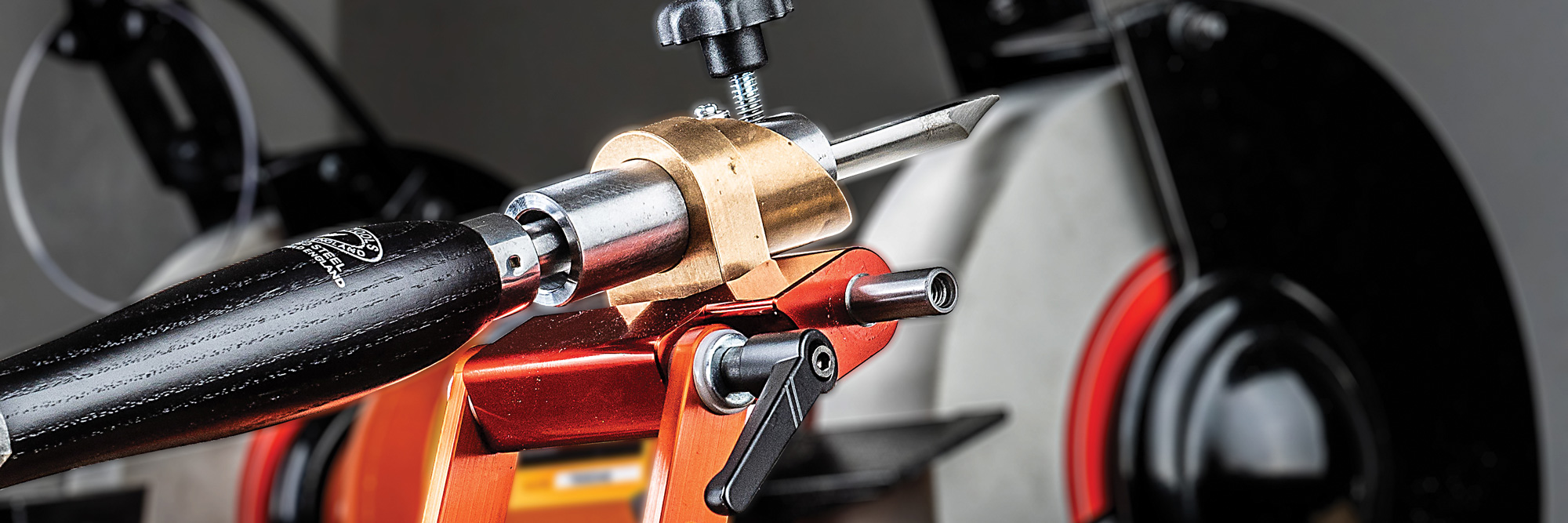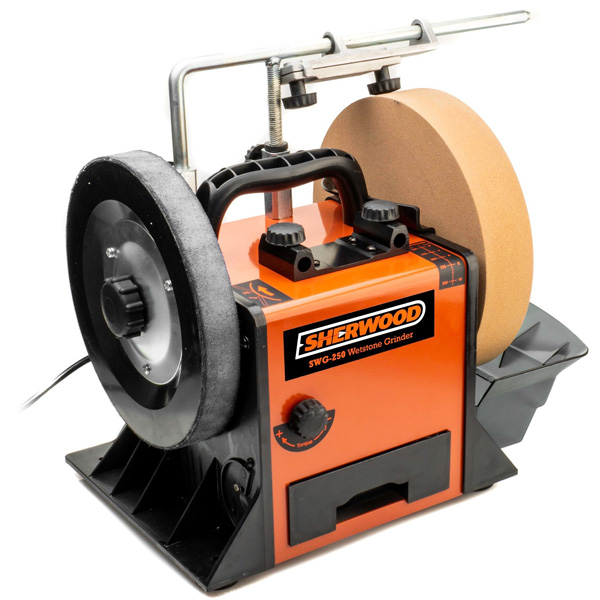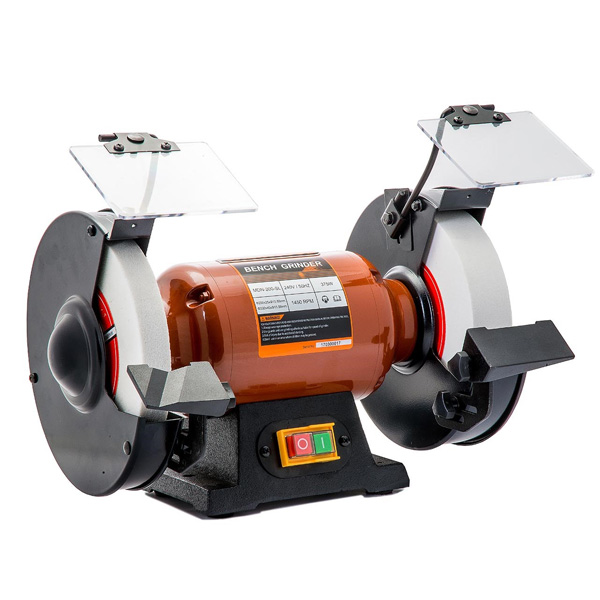
Sharpening induced anxiety is better known as Bevel Envy. A debilitating condition that affects a broad range of woodworking practitioners. This may seem like a joke, yet if you are unable to sharpen well for whatever reason - it will limit you in the craft.
Meet Jason
Jason suffers from bevel envy. He loves woodworking but he is not confident with his sharpening. He also doesn’t make time to practice. The truth about Jason is that he is a little time starved. Or maybe a little lazy. Maybe somewhere in between. He wants to improve his sharpening, yet he also doesn’t want it into a big deal. He doesn’t want to make it some sort of performance like all those “studio” woodworkers. And he certainly doesn’t want to go down the rabbit hole like the obsessive experts who dwell in the bowels of the internet. Jason wants a predictable, repeatable and express sharpening solution.
Machine sharpening is for Jason
Conveniently, Jason is very good with machines. His amazing router techniques help compensate for what he can’t achieve with a chisel. For Jason, machines are simple, and they make sense. Machine sharpening also provides a predictable, repeatable and express sharpening solution. So, machine sharpening is definitely for Jason.
Sharpening machines are relatively straightforward pieces of equipment. They work by offering a spinning abrasive wheel and a mechanism to deliver the tool bevel to the abrasive wheel in a controlled way. No real effort required on the part of the user apart from setting up and tuning the machine correctly. This makes machine sharpening perfect for all you lazy and impatient woodworkers out there.
Sharpening machines for woodworking are nothing new, yet these days they are more accessible and affordable than ever before. There are several different designs available. This article will focus attention on the two main varieties – Wet Stone Grinders and Slow Speed Bench Grinders.
WET STONE GRINDERS
Wet Stone grinders have been all the rage since Tormek developed the introduced their drill powered wet stone grinder back in the 1970’s. I have been a wet stoner myself since about 1994 having bought a Tormek Supergrind from Filthy Phil at the Sydney Wood Show – can’t remember how much it cost. Since then, a multitude of this style of wet stone grinders have emerged, including the models branded Sherwood and sold by Timbecon.

The Sherwood Wet Stone Grinder
These wet stone grinders are seductively simple and precisely engineered. The grinding wheel, a manufactured composite stone sits vertically upon a central spindle to one the side of the machine. The lower part of the stone is submerged in a removable water trough attached to the side of the unit. When operating the stone wheel is constantly bathed as the wheel rotates keeping the stone clean and cool and somewhat lubricated. The water trough is easily removed to freshen the water when required. On the opposite side, also mounted to the central spindle is a leather strop. A constantly rotating honing wheel for when you want to remove the burr, polish up an edge or touch up the tool in use.
Universal support arm
Between the two wheels is the sharpening mounting jig called the Universal Support Arm. Yes, the flash name is totally justified. The universal support arm is the heart of the machine allowing the user to mount any number of jigs on the machine allowing you to sharpen a broad range of tools. This machine can quite literally sharpen every tool from jointer blades through to fine carving tools. Supplied standard with the Sherwood wet stone grinder is the straight blade jig, designed to sharpen straight chisels and hand plane blades.
The angle finder
These wet stone grinders are supplied with an Angle Finder. You can use the angle finder to easily set the grinding angle required to suit the bevel angle of your tools you are sharpening. If you use the angle finder properly, you will never make an error and grind your bevel incorrectly.
Stone grader and truing tool
A Stone Grader is also supplied with the machine. This allows you to adjust so you can adjust the grit of the main grinding wheel from fine to less fine, depending on the edge you are grinding. Also available separately is a diamond truing tool. Being a waterstone it will need to be flattened regularly. The diamond truing tool allows you to flatten the grinding stone very easily whilst you work.
Upgrades
As I said before, the wet stone grinder can be used to sharpen a huge range of tools including knives, scissors, axes and plane blades. There is a different jig available separately for every kind of tool. In addition, the wet stone grinder also accepts a range of other upgrades. There are variety of stones available to fit to these wet stone grinders, though most users rarely need more than the one supplied standard. It is also possible to fit a CBN wheel to the wet stone grinder. For those who don’t know, CBN stands for cubic boron nitride. This material is one of the hardest materials available, second only to diamonds. These cost more than your standard abrasive wheel, though the benefits are enormous. Read on to learn more about CBN wheels. There are also a range of profiled leather strop attachments you can add to these wets tone grinders, great if you are into carving and knives.
Two model sizes
This style of grinder is available in two grinding wheel sizes – 250mm and 200mm. In my humble opinion, the 200mm version is suitable for knife sharpening and more domesticated duties than woodworking.
What does Jason think
Jason is impressed. The wet stone grinder produces a sharp edge with little fuss. And as exactly as Jason ordered – the process is predictable, repeatable and express sharpening solution.
- Predictable because the machine works in the same way every time you use it, you can set it up the same way every time and achieve the same result.
- Repeatable because the angle finder makes the set up easy and identical to how you last set up the machine.
- Express because using water stones are already an express way to sharpen, add a motor and your sharpening is now super charged.
The Curved Bevel
A point of contention. Because you are grinding on a round stone vertically, the bevel of your sharpened tool is inevitably marginally concave. For many who are used to a chisel bevel being perfectly flat this is challenging. And regular users of wet stone grinders will also argue that once the tool is sharpened and honed using the leather strop, no further work is required. No secondary bevel. No going through the stone grades up to 10000 grit!
Personally, I find this a little controversial. Even though I own a wet stone grinder my preference is to hand sharpen my bench chisels using Japanese waterstones. Why? I struggle with the concept of a curved bevel. Though the speed at which these tools work is quite seductive. And look at the time I would save. Especially if I must sharpen a bunch of student chisels. Hmmm, maybe I need to rethink my position on the curved bevel.
SHARPENING USING BENCH GRINDERS
You are all probably quite familiar with the good old bench grinder. Usually hung off the wall of a garage. Sometimes on a post in the middle of the room. Usually found inside a mechanics or welder’s workshop grinding steel with a coarse grey wheel. Things have changed. These days we now have the Sherwood Slow Speed Bench Grinder. These grinders are designed specifically for grinding tool steel and sharpening.
 The Sherwood Slow Speed Grinder
The Sherwood Slow Speed Grinder
These Sherwood machines look like a conventional bench grinder. Two wheels mounted either end of as spindle - switch front and centre. The key difference is that these machines run slow at 1400 RPM whereas your regular old skool bench grinder operates at more than twice that speed.
Why slow?
The problem with conventional bench grinders is that operate at very high speed. This is great when you want to tear away steel grinding parts for a horse float. However, if you are wanting to sharpen tools, high speed means you can inadvertently over-heat the edge of your tools and destroy the tool steel temper. This is not good as it could weaken the tool steel resulting in a brittle edge. Best avoided.
White stone wheels
Slow speed bench grinders have white stone abrasive wheels made from Aluminium oxide. These are the woodworker’s choice for bench grinding wheels as they provide a cool yet maximum cutting rate on hardened steel. They are available in different grades to suit the tools you are sharpening. They are tough and relatively slow to wear, great if you sharpen a lot. A white stone wheel fitted to your slow speed bench grinder will grind efficiently, yet not heat your tool steel excessively.
CBN wheels
Also available for slow speed grinders are CBN wheels. As mentioned above, these wheels are solid steel with bonded Cubic Boron Nitrate. CBN wheels have four times higher abrasive resistance, and twice the hardness of Aluminium oxide wheels. CBN wheels do not wear, do not ever go out of shape and do not heat the tool steel excessively. They are ideal for sharpening high speed steel (HSS) tools, in particular wood turning tools.
Woodturning?
Yes woodturning. Slow speed bench grinders are ideal for sharpening woodturning tools. Personally, I don’t really know anyone who uses a bench grinder to sharpen bench chisels or plane blades. Though I do know plenty of woodturners who sharpen all their tools on a bench grinder. A slow speed bench grinder fitted with either a white abrasive stone, or a CBN wheel, along with some sort of honing strop is the ideal sharpening setup for a woodturner. It’s fast, effective and not messy. You could go the wet stone grinder route as a turner. Keep in mind though, turners tend to sharpen a lot and regularly. So, you may find yourself perpetually flattening the soft waterstone on a wet stone grinder. Spend less time flattening and more time turning with a slow speed bench grinder.
And jigs galore!
Slow bench grinders also suit a very wide variety of sharpening jigs to help you sharpen your tools. From the Sherwood Heligrind to the Baladonia Universal Tool-rest, there is an array of tools rests and jigs to help you get an edge. Some turners have more than one grinder, each grinder set up with a particular tool rest / jig. This is to save time by not having to adjust the sharpening jig for the tool they are currently using. Afterall, woodturners tend to swap between the chisels regularly when working, and every chisel must be kept super sharp.
So, what is Jason thinking?
Jason is not a woodturner. So, he’s thinking about the Sherwood wet stone grinder. These machines are affordable, easy to use, create repeatable results and sharpen quickly. The good news for Jason is that wet stone grinders are on special at Timbecon during October, so he can save a few extra bucks as well. Good thing Jason isn’t bothered by a curved bevel.
Shop Machine Sharpening Now!